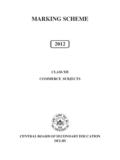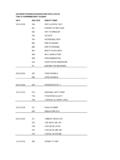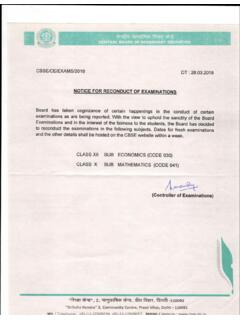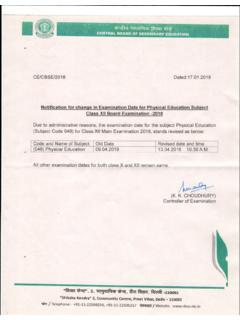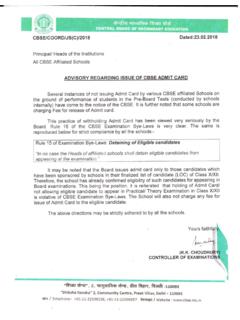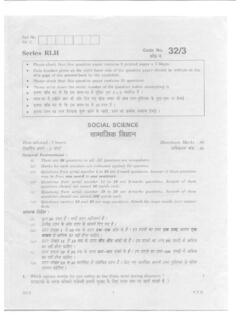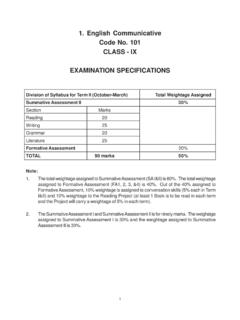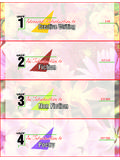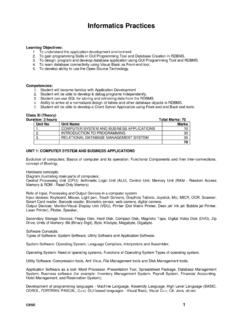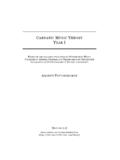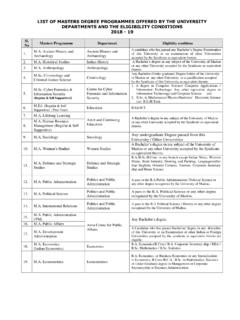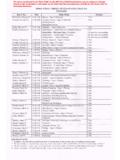Transcription of (A) MUSIC (I) HINDUSTANI MUSIC (VOCAL) – Code …
1 Contents Click here for Subjects of Internal Assessment 7. ADDITIONAL SUBJECTS. (A) MUSIC . Any one of the following can be offered : ( HINDUSTANI or carnatic ). 1. HINDUSTANI MUSIC - vocal 4. carnatic MUSIC - vocal or or 2. HINDUSTANI MUSIC Melodic Instruments 5. carnatic MUSIC - Melodic Instruments or or 3. HINDUSTANI MUSIC Percussion Instruments 6. carnatic MUSIC - Percussion Instruments (I) HINDUSTANI MUSIC ( vocal ) Code No. 034. CLASS IX. Theory 2 hours 25 Marks Practical 75 Marks THEORY 68 Pds. 1. An outline history of Indian MUSIC . 2. Definition of the following : Sangeet, Nada, Swara, Shuddha, Vikrit (Komal, Teevra) Sthana (Mandra, Madhya, Tara), Aaroha Avaroha, Raga, Laya, Tala, Sam, Tali, Khali, Matra, Avartana PRACTICAL 202 pds. 1. (a) National Anthem (b) Four folk or tribal songs (c) Four devotional songs (d) Three patriotic songs (e) Community singing (two songs).
2 2. Aaroha, Avaroha, Pakad and Drut Khyal in the following Ragas : Yaman, Bhairav, Bhopali with few tanas. 3. Recitation of the Thekas of Teentala, Kaharwa, Dadra and Jhaptal; keeping tala with hand beats. 4. Eight Tala-Baddha, Alankars set to different Talas. CLASS X. Theory 2 hours 25 Marks Practical 75 Marks THEORY 68 pds. 1. Basic knowledge of the structure and tuning of Taanpura. 2. Knowledge of the Notation systems laid down by Pt. Vishnu Digamber and Pt. Bhatkhande. 3. Definition of Vadi, Samvadi, Anuvadi, Vivadi, Alap 4. Brief description of Natya Shastra, Sangeet Ratnakar. 94. Contents PRACTICAL 202 PDS. 1. Community Singing : (a) Two songs in different regional languages. (b) One Tagore song 2. Aaroha, Avaroha, Pakad and Drut Khyal in the following Ragas : Kafi, Khamaj, Sarang and Desh with simple elaborations and few tanas.
3 Suggested Reference Books : 1. Kramik Pustak Malika by Pandit Bhatkhande 2. Rag Vigyan by Pandit Patwardhan. (II) HINDUSTANI MUSIC (MELODIC INSTRUMENTS)Code No. 035. CLASS IX. Theory 2 hours 25 Marks Practical 75 Marks THEORY 68 PDS. 1. An outline history of Indian MUSIC . 2. Definition of the following : Sangeet, Nada, Swara, Shuddha, Vikrit (Komal, Teevra) Sthana (Mandra, Madhya, Tara), Aaroha Avaroha, Raga, Laya, Tala, Sama, Tali, Khali, Matras, Avartana. PRACTICAL 202 pds. 1. Proficiency in any one of the following instruments : (i) Sitar, (ii) Sarod, (iii) Violin, (iv) Dilruba or Esraj (v) Flute (vi) Mandolin, (vii) Guitar. 2. (a) The tune of National Anthem. (b) Four light Dhuns and four folk dhuns of different regions. 3. Aaroha, Avaroha, Pakad and Drut gat in the following Ragas; Yaman Bhairav, Bhopali with few Todas.
4 4. The recitation of Thekas of Teen Taal, Keharwa, Dadra and Jhaptal, taal keeping with hand beats. 95. Contents CLASS X. Theory 2 hours 25 Marks Practical 75 Marks THEORY 68 pds 1. Basic knowledge of the structure and tuning of any one of the following instruments : (i) Sitar, (ii) Sarod, (iii) Violin, (iv) Dilruba or Esraj, (v) Flute, (vi) Mandolin, (vii) Guitar. 2. Knowledge of the Notation systems laid down by Pt. Vishnu Digamber Paluskar and Pt. Bhatkhande. 3. Vadi, Samvadi, Anuvadi, Vivadi, Alap. 4. Brief description of Natya Shastra, Sangeet Ratnakar. PRACTICAL 202 pds. 1. Eight Tala-baddha Alankaras set to different Talas. 2. Aaroha, Avaroha, Pakad and Drut gat in the following Ragas : Kafi, Khamaj, Sarang and Desh with simple elaborations and few Todas.
5 Suggested Reference Books : 1. Sitar Marg (I Part) by Shri S. Bandyopadhyaya, Vani Mandir, Subzi Mandi, Delhi-7. 2. Vitat Vadya Shiksha', by Shri S. Bandyopadhyaya, Vani Mandir, Subzi Mandi, Delhi-7. 3. Sitar and its Technique by Prof. Debu Chaudhuri, Avon Publishers, Shahdara, Delhi. (III) HINDUSTANI MUSIC (PERCUSSION-INSTRUMENTS). CODE NO. 036. CLASS IX. Theory 2 hours 25 Marks Practical 75 Marks THEORY 68 pds. 1. An outline history of Indian MUSIC . 2. Definition of the following : Sangeet, Nada, Swara, Shuddha, Vikrit (Komal, Teevra) Raga, Laya, Tala, Matra, Vibhag, Sama, Tali Avartana, Dugun, Tigun, Chaugun. 96. Contents PRACTICAL 202 pds. To acquire efficiency in playing on the opted percussion instrument (Tabla or Pakhawaj) with special reference to accompaniment.
6 1. Ability to recite with hand beats and to play on the instruments the Theka of Teen Taal, Kaharwa, Dadra, with simple elaborations. 2. Accompaniment with solo performance. CLASS X. Theory 2 hours 25 Marks Practical 75 Marks THEORY 68 pds. 1. Basic knowledge of the structure and tuning of the instruments (Tabla or Pakhawaj). 2. Knowledge of the Notation systems laid down by Pt. Vishnu Digamber Paluskar and Pt. Bhatkhande. 3. Definition of Avartan, Theka, Lahera, Amad, Mohra, Tihai. 4. Brief description of Natya Shastra, Sangeet Ratnakar. PRACTICAL 202 pds. 1. To produce correctly the basic Bolas - Ta, Dha, Tin and Dhin, Dha, Ki, Na, Ti, Dhi, Dhi, Na and Ti; Ti, Na, Dhi, Dhi, Ga, Tir, Kit, Tu, Na, Katta, etc. 2. Ability to recognise the tala of the composition being sung or played on a melodic instrument.
7 3. To recite the tala with hand beats and to play on the instrument the Theka of Jhaptala, Rupak and Ektala with elaborations. Suggested Reference Books : 1. Tal Sastra' by Shri Bhagwat Sharan, Sangit Hathras. 2. Tabla Vadan Shiksha by Pt. Krishna Rao Shankar Pandit. (IV) carnatic MUSIC ( vocal ) CODE NO. 031. CLASS IX. Theory 2 hours 25 Marks Practical 75 Markss THEORY 68 pds. 1. Knowledge of the following terms : Sangita, Naada, Swara, Svarsthana, Arohana, Avarohana, Aavarta, Sruti, Taala, Laya, Alankara, Sthayi, Graha or Eduppu, Dhaatu, Maatu or Degrees of Speed, Anya Svara, Suddha Svara, Vikrta, Svara, Sangati, Poorvaanga, Uttaranga, Vaadi Samvaadi, Anuvaadi, Vivaadi, Samam, Atita, Anaagata, Raaga. 97. Contents 2. Outlines of Raaga, Lakshanaas of the following : Maayaamaalavagowla, Sankaraabharanam, Kharaharapriya, Hamsadhvani.
8 3. Lakshanaas of the following musical forms : Gitam, Svarajati, Varnam. 4. Basic knowledge of the following Taalas : Aadi, Roopakam, Chaapu. 5. An outline history of Indian MUSIC , including the biography of Purandaradaasa and Tyaagaraaja. PRACTICAL 202 pds. 1. Community Singing : (a) National Anthem (b) Five folk or tribal songs of any region indicating time of the year and occasion with which they are related. 2. Voice-culture exercises for Sruti Suddha and Sthana Suddha. 3. The following ragas with descriptive details : Maayaamaalavagowla, Sankaraabharanam, Kharaharapriya, Hamsadhvani. 4. Singing of simple, Devarnaamaas and Tiru Pugazh to the accompaniment of Tambura and Mridangam. 5. Soolaadi Sapta Talas and Chaapu Talas. Suggested Reference Books : South Indian MUSIC Publishing Home : Volumes I, II, III & IV by Prof.
9 P. Sambamoorthy. CLASS X. Theory 2 hours 25 Marks Practical 75 Marks THEORY 68 pds. 1. Raaga Lakshana outlines of the following : Mohanam, Kalyaani, Kaambhoji, Bhairavi. 2. Lakshanas of Keertana and Kriti. 3. Outlines knowledge of the seventy-two Melakarta Scheme 4. Basic Knowledge of the structure and tuning of the Tambura. 5. Principles of Notation in Karnataka MUSIC . 98. Contents PRACTICAL 202 pds. 1. Community Singing : Four devotional songs, simple Naamaavalis, Bhajans composed by the saints/poets of India. 2. The following ragas with descriptive details : Mohanam, Kalyaani, Kaambhoji, Bhairavi. 3. To create proper sense of svara and laya through sapta tala alankaaras. Alankaaras in Moyaamaalava gowla and other simple scales. 4. Divyanaama keertanas and simple kritis, to the accompaniment of Tambura and Mridangam.
10 5. Principles of notation in carnatic MUSIC , illustrated with suitable examples. (V) carnatic MUSIC (MELODIC INSTRUMENTS) CODE NO. 032. CLASS IX. Theory 2 hours 25 Marks Practical 75 Marks THEORY 68 pds. 1. Knowledge of the following terms : Sangita, Naada, Swara, Svarsthana, Arohana, Avarhana, Aavarta, Sruti, Sthayi, Graha or Eduppu, Dhaatu, Maatum Sama, Kaala of Degrees of Speed, Suddha Svara Vikrta, Svara, Sangati Poorvaanga, Uttaranga, Vaadi, Samvaadi, Anuvaadi, Vivaadi, Atita, Anaagata, Anya svara. 2. Raaga, Lakshanaas Outlines of : Maayaamaalavagowla, Sankaraabharanam, Kharaharapriya, Hamsadhvani. 3. Lakshanaas of the musical forms geetam, svarajati and Varnam. 4. Taalas : Aadi, Roopakam and Chaapu. 5. An outlines history of Indian MUSIC including the biography of Purandaradaasa and Tyaagaraaja.
